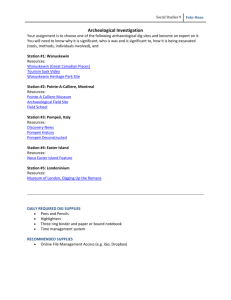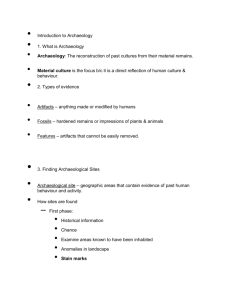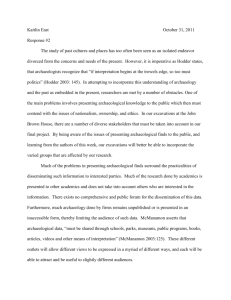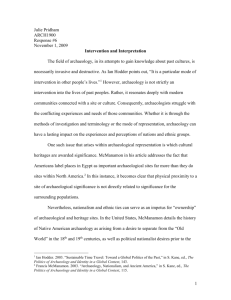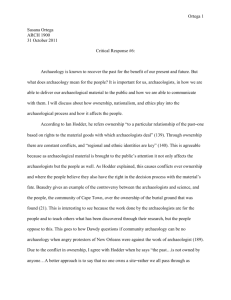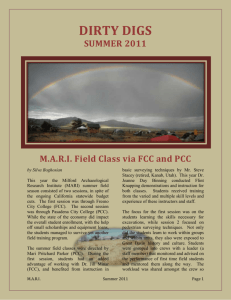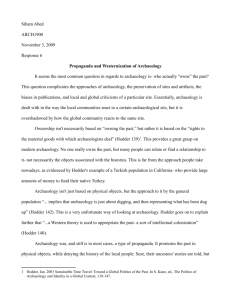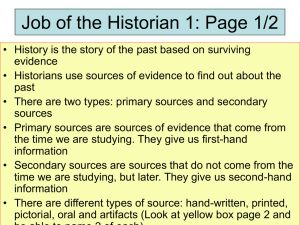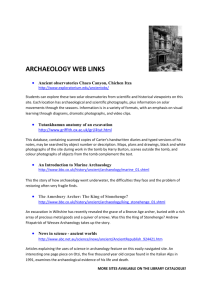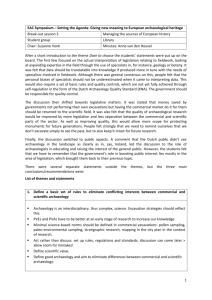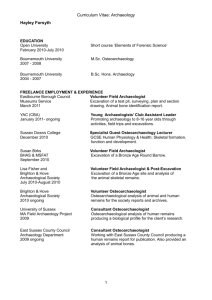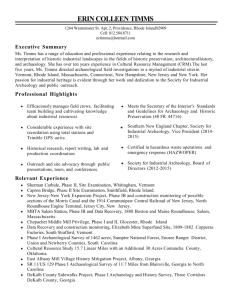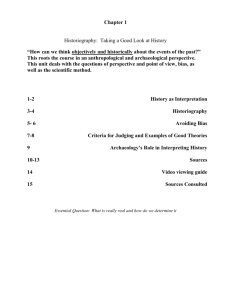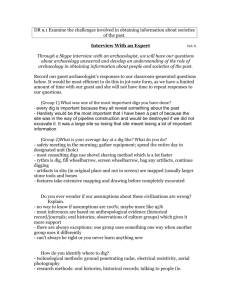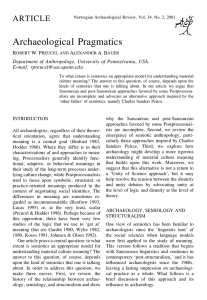Christopher Thompson Nov 1 Response
advertisement
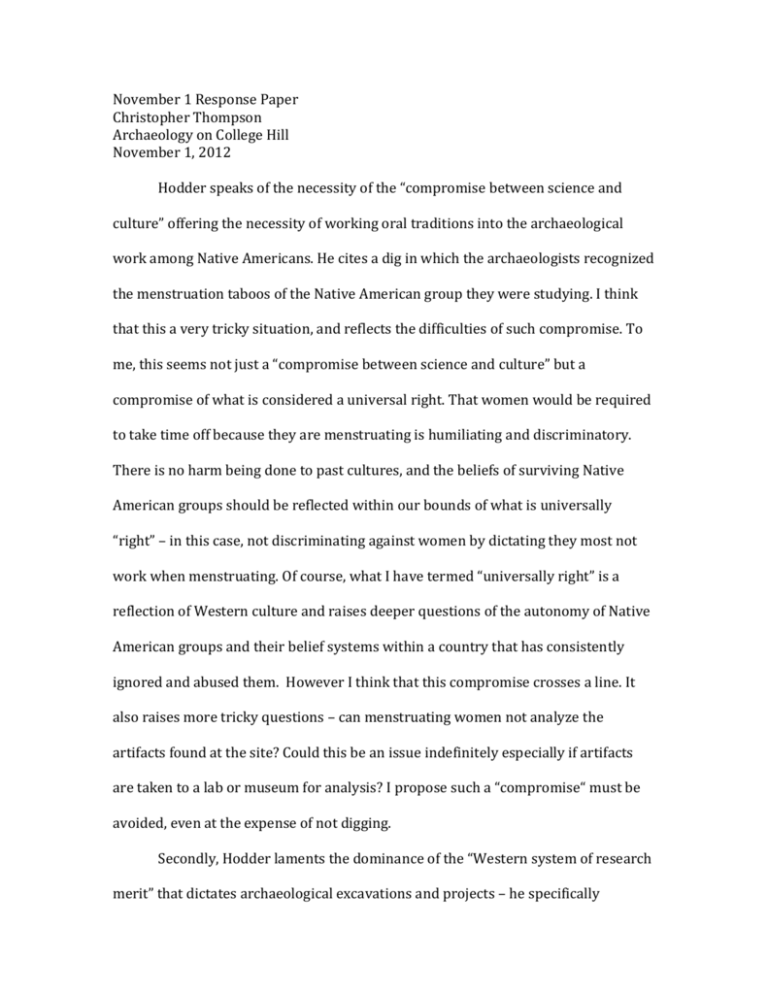
November 1 Response Paper Christopher Thompson Archaeology on College Hill November 1, 2012 Hodder speaks of the necessity of the “compromise between science and culture” offering the necessity of working oral traditions into the archaeological work among Native Americans. He cites a dig in which the archaeologists recognized the menstruation taboos of the Native American group they were studying. I think that this a very tricky situation, and reflects the difficulties of such compromise. To me, this seems not just a “compromise between science and culture” but a compromise of what is considered a universal right. That women would be required to take time off because they are menstruating is humiliating and discriminatory. There is no harm being done to past cultures, and the beliefs of surviving Native American groups should be reflected within our bounds of what is universally “right” – in this case, not discriminating against women by dictating they most not work when menstruating. Of course, what I have termed “universally right” is a reflection of Western culture and raises deeper questions of the autonomy of Native American groups and their belief systems within a country that has consistently ignored and abused them. However I think that this compromise crosses a line. It also raises more tricky questions – can menstruating women not analyze the artifacts found at the site? Could this be an issue indefinitely especially if artifacts are taken to a lab or museum for analysis? I propose such a “compromise“ must be avoided, even at the expense of not digging. Secondly, Hodder laments the dominance of the “Western system of research merit” that dictates archaeological excavations and projects – he specifically recognizes the blind-eye turned toward local interests and other non-academic stakeholders. However, Hodder ignores that archaeology is a field of Western academia and that its aims reflect that. While I understand the stakeholder interests must be taken into account, the primary purpose of excavation is a research question. The British Academy and the AHRB should take into sensitivity to local concerns – however I think that attention to research design is a noble focus – one that successfully avoids the corrosive lure of commercial or other exploitation– and is the historical and philosophical basis of archaeology as a social science. Central to Hodder’s article is the question of responsibility for all those impacted by archaeological work – including the local community and those who claim heritage to the site. He implies that archaeologists should not only record their findings, but the responses of the local people. This is interesting to consider in regard to our own dig on College Hill. Who would the stakeholders include – the student body? All the alumni? The professors, and administrators? The families who live on College Hill? The University is a peculiar institution in that it has had thousands and thousands of men and women who have collectively shaped the path of the school profoundly, but have done so in sequences of four years only to drop away, a part of a precise and incessant diaspora. When we began digging on the green I felt strange cutting through the sod Facilities has done so much to maintain – it reminded me that Archaeology is truly a destructive process. After reading Hodder’s article I realize that this destruction is not just one of displaced earth and artifacts, but also the unearthing of objects that may hold deep value and symbolism for people. As scientists we attempt to find objective value, clues to past culture. However for other groups involved this may be emotional or spiritual value. Even the act of unearthing, bringing to light can be destructive in that it may affect someone else. We have changed their outlook, and this is destructive. This is a responsibility that lies with the archaeologist. It is interesting that interest in early American archaeology was paralleled by interest in the striking American landscapes of Yosemite Valley and Yellowstone. Both, as McManamon implies, reflect a greater interest in symbols of America. However this comparison discounts the role of white conquerors (namely the Spanish) and settlers in the history of the native groups. In other words, 20th century Americans saw the grandeur of Yellowstone as they did the complexity of the Mesa Verde dwellings: timeless awesome landscapes that complement well the young, strengthening country. Gone are the narratives of sickness, abandon, and native human culture that should accompany the interest in the Native American sites. This progressive movements figure headed by Roosevelt forgot to ask some crucial questions about what it meant to be American, which the true Americans were, and how these monuments belie this young Nationalism NcManamon cites Schlesinger, “the cult of ethnicity exaggerates differences, intensifies resentments and antafonisms, drivers even deeoer the awful wedge between races and nationalities. The endgame is self-pity and self-ghettoization.” I think Schlesinger unfairly villainizes this “cult of ethnicity” attaching a negative and violent connation to what may be a constructive (although) heated conversation on ethnic identity and pride. The term “cult” is strongly negative and fails to take into account the broad spectrum of groups focused on ethnic rights. For example, the differences in the beliefs MLK Jr. to those of Stokely Carmichael, both of whom struggled for the rights of an ethnic minority. Schlesinger is also silent on historical wrongs, and historical trauma – who is he to decide what is an exaggeration of differences? I do recognize that resentment, antagonism, and unproductive wedge that has arisen from discussion and legislation concerning ethnicity, however I feel that the onus of this negativity does not lie with the “cult of ethnicity” but with the historical and contemporary wrongs committed. I would like to look at the anti-archaeology perspectives that have been taken up by some groups of American Indians, Australian aborigines, and ultra-Orthodox Jews as discussed by McManamon. Why do they attack the discipline of archaeology and not other academic disciplines, specifically history which examines the historical record of these same groups (for example, how many academic articles have been written on the Old Testament?)? I think the answer is, to some degree they do, but that archaeology seeks to dig up what is buried, to uncover what may not be known and this is dangerous to these groups. Dangerous, because these artifacts may hold important and spiritual value to these ethnic groups and (although we legally decommodified archaeological artifacts) they remain safer under the ground, rather than in the hands of men and women whose system of beliefs and objectives are so different from their own. Secondly, I believe that material culture and the interpretation by Western academics could be perceived as threatening to the stories and religion that these groups hold to. They do not feel they must still defend their beliefs on the ever-looming system of modern Western thought. It is important, as an archaeologist, to understand that the value of a material culture expands beyond the horizons of academia. Academia is perceived to be the center of Western achievement and development – it has grown up alongside our most-lauded societies and civilization, has housed our greatest thinkers, created and perpetuated such images as the sun of knowledge – the same which breaks through the clouds of ignorance on our own Brown seal, and the temple of wisdom which stand at the heart of “Western civilization.” We understand that knowledge is sacred, our universities are bastions of progressivism, and objectivity trumps all. However, buried under all this is the people whom we study, for an archaeologist through material culture. The truly progressive academic must understand when to put aside objectivity and recognize and accept compromise, while staying true to the mission he or she has given him or herself to as a scientist.
